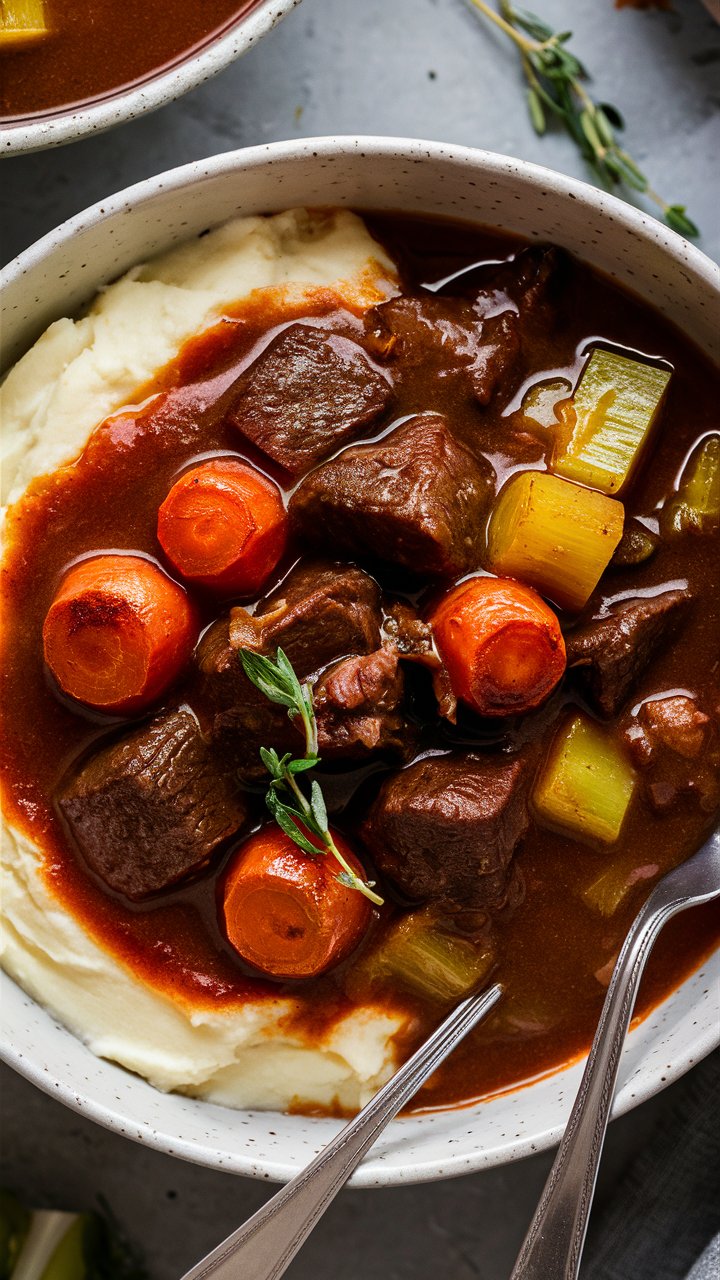
Slow-Braised Dutch Oven Pot Roast with Rich Gravy 2025
When it comes to cozy, hearty dinners that impress without hours of fuss, few dishes can match the magic of a Dutch Oven Pot Roast. This classic recipe transforms a simple cut of beef into a tender, flavorful masterpiece, slow-braised to perfection in its own juices, vegetables, and a rich aromatic sauce. Whether it’s a quiet weeknight or a special Sunday gathering, this one-pot comfort meal promises melt-in-your-mouth meat, savory vegetables, and a sauce so rich you’ll want to soak up every drop.
In this guide, we’ll cover everything from ingredient selection to step-by-step cooking instructions, tips for achieving fork-tender beef, and creative variations that elevate this dish into a culinary showstopper.
Why You’ll Love This Dutch Oven Pot Roast
There’s a reason the Dutch Oven Pot Roast has remained a family favorite for generations. Here’s why it stands out:
1. One-Pot Wonder
Cleanup is minimal, as everything from meat to vegetables cooks together. No juggling multiple pans or dirtying countless dishes.
2. Deep, Complex Flavors
A combination of red wine, beef stock, garlic, onions, and fresh herbs infuses each bite with layers of savory richness. The long, slow braise unlocks flavors that quick cooking simply can’t replicate.
3. Fork-Tender Beef Every Time
With the right cut and proper cooking technique, the roast falls apart effortlessly. No chewing required—just succulent, juicy beef.
4. Perfect for Meal Prep
This dish often tastes even better the next day. The flavors intensify overnight, making it an ideal choice for leftovers or advance cooking.
5. Crowd-Pleasing Comfort Food
Whether serving family or guests, the combination of tender beef, vegetables, and a luscious gravy is universally appealing.
Essential Ingredients and Why They Matter
Selecting the right ingredients ensures your pot roast is flavorful, tender, and balanced.
1. Beef Chuck Roast
The marbling and connective tissue in chuck roast break down during long cooking, creating juicy, tender meat. Alternatives include brisket or bottom round, though cook times may vary.
2. Red Wine
Red wine adds depth and a subtle tanginess that enhances the savory flavors. Choose a wine you’d enjoy drinking; dry wines like Cabernet Sauvignon or Merlot work best.
3. Beef Stock
A rich stock provides the liquid base, supporting slow cooking while creating a naturally flavorful sauce.
4. Aromatics: Carrots, Onions, Garlic
Carrots offer natural sweetness, onions give savory depth, and garlic adds a fragrant punch. Together, they balance the richness of the beef.
5. Tomato Paste
A spoonful of tomato paste adds umami richness, intensifying the sauce without overpowering other flavors.
6. Fresh Herbs: Thyme, Bay Leaf, Parsley
Herbs add complexity and freshness. Thyme and bay leaf lend earthy notes, while parsley brightens the dish at the end.
Tips Before You Start
To achieve restaurant-quality results, consider these key tips:
- Bring Meat to Room Temperature – This ensures even cooking. Let it rest for at least 30–60 minutes before searing.
- Don’t Rush the Searing Step – Browning the meat develops flavor through the Maillard reaction. Take your time; a deep brown crust is crucial.
- Use a Heavy Dutch Oven – Cast iron distributes heat evenly and retains it, ideal for slow braising.
- Include Wine or an Acidic Component – This balances richness and enhances sauce depth.
- Low and Slow – Patience is key. Long cooking times break down connective tissues for ultimate tenderness.
How to Make Dutch Oven Pot Roast: Step by Step
Here’s a detailed, beginner-friendly guide to cooking the perfect pot roast.
Step 1: Prepare the Roast
- Season the beef generously with salt and freshly ground black pepper on all sides.
- Let it rest at room temperature for 1 hour.
- Preheat your oven to 325°F (165°C).
Step 2: Sear the Meat
- Heat 2 tablespoons of vegetable oil in a Dutch oven over medium-high heat.
- Sear the roast for 4–5 minutes per side until a deep, golden crust forms.
- Transfer the roast to a plate and set aside.
Step 3: Sauté the Aromatics
- Reduce heat to medium. Add chopped onions and sauté until golden brown.
- Stir in minced garlic and cook 30–60 seconds until fragrant.
Step 4: Build the Sauce Base
- Stir in 2 tablespoons of tomato paste and cook for 1–2 minutes.
- Deglaze the pan with 1–2 cups of red wine, scraping up browned bits from the bottom.
- Simmer 3–5 minutes to slightly reduce.
Step 5: Assemble and Braise
- Return the seared roast to the Dutch oven.
- Add 2–3 cups of beef stock, carrots, bay leaves, thyme, and parsley stems.
- Bring to a gentle simmer, cover, and transfer to the oven.
Step 6: Slow Cook
- Bake for 3–4 hours, or until the meat is fork-tender.
- Check halfway through, basting the roast with pan juices if desired.
Step 7: Rest and Serve
- Remove the roast and let it rest for 10–15 minutes.
- Slice or shred, discard bay leaves and herb stems, and serve with vegetables and pan sauce.
What to Serve With Your Pot Roast
Pairing the roast with complementary sides elevates the meal:
- Mashed Potatoes or Creamy Polenta – Perfect for soaking up rich gravy.
- Crusty Bread – Ideal for dipping.
- Roasted or Steamed Vegetables – Green beans, Brussels sprouts, or roasted parsnips.
- Wine Pairing – A bold red like Cabernet Sauvignon or Merlot complements the dish beautifully.
Variations & Ingredient Swaps
Experiment to suit your taste or dietary needs:
- Bone-In Chuck Roast – Adds extra flavor to the braise.
- Additional Vegetables – Potatoes, parsnips, or turnips can be added in the last hour of cooking.
- Non-Alcoholic Version – Substitute red wine with beef broth and a splash of balsamic vinegar.
- French Twist – Replace thyme and parsley with herbes de Provence.
- Spicy Version – Add a pinch of red pepper flakes or smoked paprika to the braising liquid.
Storage, Reheating & Meal Prep
One of the best things about pot roast is that it improves over time:
- Fridge: Store in an airtight container for up to 4 days.
- Freezer: Freeze in the braising liquid for up to 2 months. Thaw overnight in the fridge.
- Reheating: Gently reheat on the stovetop over low heat or in the microwave. Add a splash of broth to keep meat moist.
Common Mistakes and How to Avoid Them
Even experienced cooks sometimes struggle with pot roast. Here’s how to avoid pitfalls:
- Skipping the Sear: You’ll lose flavor and color. Always brown meat first.
- Overcooking Vegetables: Add soft vegetables like carrots and potatoes later to prevent mushiness.
- Using the Wrong Cut: Avoid lean cuts like sirloin; they can become dry.
- Not Enough Liquid: Ensure the roast is partially submerged in liquid to prevent drying out.
Frequently Asked Questions (FAQs)
Can I use a different cut of beef?
Yes, brisket or bottom round can work, though cooking times may need adjustment.
Do I have to use red wine?
No, but it adds depth. You can substitute beef broth with a splash of balsamic vinegar.
Can I make this in a slow cooker?
Absolutely. Sear the meat first, then cook on low for 8–9 hours.
Can I thicken the sauce?
Yes, simmer the pan juices uncovered on the stove until reduced.
Why sear the meat first?
Searing creates a deep flavor through the Maillard reaction. It’s worth the extra step.
Can I prepare it ahead of time?
Yes. Leftovers taste even better the next day, as the flavors have more time to meld.
Final Thoughts
A Dutch Oven Pot Roast is more than just a meal—it’s an experience. The rich aroma, fork-tender beef, and perfectly braised vegetables make it the ultimate comfort food. By following these tips, experimenting with variations, and pairing it with thoughtful sides, you’ll create a dish that delights every time.
Whether it’s a quiet weeknight dinner, a special occasion, or a meal prep favorite, this one-pot wonder brings warmth, flavor, and satisfaction to any table. Don’t forget the crusty bread to soak up every last drop of that exquisite gravy—it’s truly the finishing touch to a dish worth savoring.


